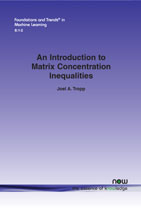An Introduction to Matrix Concentration Inequalities
By Joel A. Tropp, California Institute of Technology, USA, jtropp@cms.caltech.edu
Abstract
Random matrices now play a role in many areas of theoretical, applied, and computational mathematics. Therefore, it is desirable to have tools for studying random matrices that are flexible, easy to use, and powerful. Over the last fifteen years, researchers have developed a remarkable family of results, called matrix concentration inequalities, that achieve all of these goals.
This monograph offers an invitation to the field of matrix concentration inequalities. It begins with some history of random matrix theory; it describes a flexible model for random matrices that is suitable for many problems; and it discusses the most important matrix concentration results. To demonstrate the value of these techniques, the presentation includes examples drawn from statistics, machine learning, optimization, combinatorics, algorithms, scientific computing, and beyond.
An Introduction to Matrix Concentration Inequalities
Random matrices now play a role in many areas of theoretical, applied, and computational mathematics. It is therefore desirable to have tools for studying random matrices that are flexible, easy to use, and powerful. Over the last fifteen years, researchers have developed a remarkable family of results, called matrix concentration inequalities, that achieve all of these goals.
This monograph offers an invitation to the field of matrix concentration inequalities. It begins with some history of random matrix theory; it describes a flexible model for random matrices that is suitable for many problems; and it discusses the most important matrix concentration results. To demonstrate the value of these techniques, the presentation includes examples drawn from statistics, machine learning, optimization, combinatorics, algorithms, scientific computing, and beyond.
